|
|
 |
Fiche d'espèce de Copépode |
|
|
Cyclopoida ( Ordre ) |
|
|
|
Corycaeidae ( Famille ) |
|
|
|
Corycaeus ( Genre ) |
|
|
|
Corycaeus ( Sous-Genre ) |
|
|
| |
Corycaeus (Corycaeus) speciosus Dana, 1849 (F,M) | |
| | | | | | | Syn.: | ? Corycäus longicaudis Dana, 1849; 1852 (juv.); ? Tanaka, 1960 (p.90, figs.F [= juv.]); ? Chen & al., 1974 (p.66, figs.F[ = ? juv.]);
Corycäus speciosus : Giesbrecht, 1892 (p.660, 673, 772, figs.F);
no Corycäus longicaudis : Giesbrecht, 1891; 1892 (p.661, 675, figs.F);
Corycella speciosus : Moore, 1949 (p.64);
? Corycaeus (Corycella) longicaudis : Zheng & al., 1982 [p.151, Fig.F); Zuo & al., 2006 (p.163: tab.1)
Corycaeus speciosus : Bainbridge, 1972 (p.61, Appendix Table I: vertical distribution vs day/night, Table II: %, Table IV: seasonal abundance); Corral Estrada & Pereiro Muñoz, 1974 (tab.I); Dessier, 1983 (p.89, Tableau 1, 2, Rem., %); Böttger-Schnack, 1995 (p.92; Boxshall & Halsey, 2004 (p.494); McKinnon & al., 2008 (p.843: Tab.1); Lan Y.-C. & al., 2009 (p.1, Table 2, % vs hydrogaphic conditions); Vives & Shmeleva, 2010 (p.198, figs.F,M, Rem.); Belmonte & al., 2013 (p.222, Table 2, abundance vs stations); Rakhesh & al., 2013 (p.7, Table 1, 4, abundance vs stations); Lopez-Ibarra & al., 2014 (p.453, fig.6, biogeographical affinity); Zakaria & al., 2016 (p.1, Table 1); Jerez-Guerrero & al., 2017 (p.1046, Table 1: temporal occurrence); El Arraj & al., 2017 (p.272, table 2, spatial distribution); | | | | Ref.: | | | F. Dahl, 1894 (p.73); Brady, 1883 (p.115, figs.F); Thompson, 1900 c (p.292); Thompson & Scott, 1903 (p.240, 285); A. Scott, 1909 (p.251, Rem.); Wolfenden, 1911 (p.359); Farran, 1911 a (p.289); M. Dahl, 1912 (p.13, figs.F,M, Rem. p.132); Früchtl, 1924 b (p.102); Farran, 1929 (p.211, 291); Rose, 1929 (p.68); Wilson, 1932 a (p.358, figs.F,M); Klevenhusen, 1933 a (p.85, chart 37); Rose, 1933 a (p.326, figs.F,M); Dakin & Colefax, 1933 (p.209); Farran, 1936 a (p.134); Mori, 1937 (1964) (p.133, figs.F,M); Dakin & Colefax, 1940 (p.111, figs.F,M); Wilson, 1942 a (p.182, fig.F); Lysholm & al., 1945 (p.44); Oliveira, 1946 (p.475, figs.M); Sewell, 1947 (p.276, Rem.F,M, Rem.); Krishnaswamy, 1953 (p.70, figs.F,M); Chiba & al., 1957 (p.310); 1957 a (p.12); Tanaka, 1957 (p.79, figs.F,M); Marques, 1958 a (p.144); Tanaka, 1960 (p.78); Fish, 1962 (p.27); Motoda, 1963 (p.213, figs.F,M); Cervigon, 1964 (p.164, figs.F,M); Owre & Foyo, 1967 (p.120, figs.F,M); Marques, 1968 a (p.396); Corral Estrada, 1970 (p.235); Ramirez, 1971 (p.91, figs.F,M); Björnberg, 1972 (p.97, figs.N); Marques, 1973 (p.248); Chen & al., 1974 (p.53, figs.F,M); Marques, 1975 (p.53); 1976 (p.1001); Björnberg & al., 1981 (p.675, figs.F,M); Marques, 1982 (p.775); Sazhina, 1982 (p.1161, Rem., fig.N); 1985 (p.94, figs.N); Zheng Zhong & al., 1984 (1989 ) (p.267, figs.F,M); Kang & al., 1990 (p.51, figs.F,M); Kim & al., 1993 (p.271); Chihara & Murano, 1997 (p.966, Pl.218: F,M); Boxshall, 1998 (p.222); Bradford-Grieve & al., 1999 (p.887, 974, figs.F,M); Conway & al., 2003 (p.248, figs.F,M, Rem.) ; | 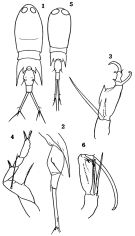 issued from : O. Tanaka in J. Fac. Agricult. Kyushu Univ., 1957, 11 (1). [Pl.3, Figs.1-6]. Female (from Japanese waters): 1, habitus (dorsal); 2, urosome (lateral right side); 3, A2; 4, P4. Nota: Head and 1st thoracic segment partially fused. The abdominal segments and furca in the proportional lengths 38:16:46. Furcal rami long and divergent (characteristic featureof the species) Male: 5, habitus (dorsal); 6, A2. Nota: Head and 1st thoracic segment fused. Anterior segment about 1.8 times as long as wide. Posterior corners of 3rd thoracic segment exceed the middle of the genital segment. The abdominal segments and furca in the proportional lengths 33:21:46. Genital segment about 3/5 as wide as long (14:9). Anal segment more than 2 times as wide as long. Furcal rami about 12 times as long as wide.
|
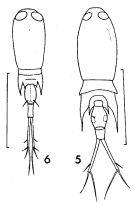 issued from : F.C. Ramirez in Revta Mus. La Plata, Seccion Zool., 1971, XI. [Lam.III, Figs.5, 6]. Female (from off Mar del Plata): 5, habitus (dorsal). Male: 6, habitus (dorsal). Scale bars in mm: 1
|
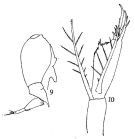 issued from : Q.-c Chen & S.-z. Zhang & C.-s. Zhu in Studia Marina Sinica, 1974, 9. [Pl.23, Figs.9-10]. As Corycaeus (Corycella) longicaudis.Doubtful (perhaps juvenile). Female (from China Seas): 9, habitus (lateral right side); 10, A2.
|
 issued from : Q.-c Chen & S.-z. Zhang & C.-s. Zhu in Studia Marina Sinica, 1974, 9. [Pl.14, Figs.9-13]. Female (from China Seas): 9, habitus (dorsal); 10, A2; 11, P4. Male: 12, habitus (dorsal); 13, A2.
|
 Issued from : W. Giesbrecht in Systematik und Faunistik der Pelagischen Copepoden des Golfes von Neapel und der angrenzenden Meeres-Abschnitte. – Fauna Flora Golf. Neapel, 1892. Atlas von 54 Tafeln. [Taf.51, Fig.40]. As Corycäus speciosus. Female: 40, habitus (dorsal).
|
 Issued from : W. Giesbrecht in Systematik und Faunistik der Pelagischen Copepoden des Golfes von Neapel und der angrenzenden Meeres-Abschnitte. – Fauna Flora Golf. Neapel, 1892. Atlas von 54 Tafeln. [Taf.51, Fig.39]. As Corycäus speciosus. Male: 39, habitus (dorsal).
|
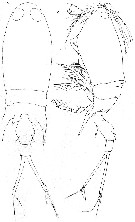 issued from : M. Dahl in Ergebnisse der Plankton-Expedition der Humboldt-Stiftung. Bd II, G. f1. I. Die Corycaeinen 1912. [Taf.I, Figs.1, 2]. Female: 1, habitus (dorsal); 2, idem (lateral left side).
|
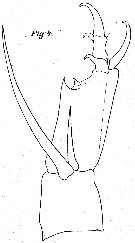 issued from : M. Dahl in Ergebnisse der Plankton-Expedition der Humboldt-Stiftung. Bd II, G. f1. I. Die Corycaeinen 1912. [Taf.I, Fig.4]. Female: 4, A2.
|
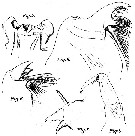 issued from : M. Dahl in Ergebnisse der Plankton-Expedition der Humboldt-Stiftung. Bd II, G. f1. I. Die Corycaeinen 1912. [Taf.I, Figs.5, 6, 7, 8, 9]. Female: 5, labrum; 6, Md; 7, Mx1; 8, Mx2; 9, Mxp.
|
 issued from : M. Dahl in Ergebnisse der Plankton-Expedition der Humboldt-Stiftung. Bd II, G. f1. I. Die Corycaeinen 1912. [Taf.I, Figs.10, 11, 12, 13]. Female: 10, P1; 11, P2; 12, P3; 13, P4.
|
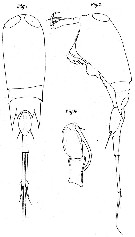 issued from : M. Dahl in Ergebnisse der Plankton-Expedition der Humboldt-Stiftung. Bd II, G. f1. I. Die Corycaeinen 1912. [Taf.II, Figs.1, 2, 4]. Male: 1, habitus (dorsal); 2, idem (left side); 4, Mx2.
|
 issued from : M. Dahl in Ergebnisse der Plankton-Expedition der Humboldt-Stiftung. Bd II, G. f1. I. Die Corycaeinen 1912. [Taf.I, 3]. Male: 3, A1.
|
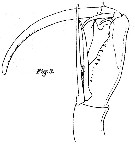 issued from : M. Dahl in Ergebnisse der Plankton-Expedition der Humboldt-Stiftung. Bd II, G. f1. I. Die Corycaeinen 1912. [Taf.II, Fig.3]. Male: 3, A2.
|
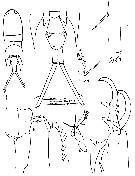 issued from : F. Cervigon iin Mem. Soc. Cienc. nat. La Salle, 1964, 24 (68). [p.165, Lam.1]. As Corycaeus speciosus. Female (from Venezuela): 1, habitus (dorsal); 2, abdomen (dorsal); 3, distal poat of caudal ramus; 4, A2; 5, distal part of A2; 6, exopod segments 1 and 2 of P4; 7, exopod segment 3 of P4; 8, P4. Nota: Lengths ratio genital, anal segments and caudal rami 36:15:49 and 35:16:49
|
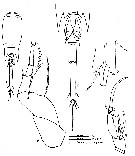 issued from : F. Cervigon iin Mem. Soc. Cienc. nat. La Salle, 1964, 24 (68). [p.166, Lam.2]. As Corycaeus speciosus. Male: 1, habitus (dorsal); 2, abdomen (dorsal); 3, distal part of caudal rami; 4, A2; 5, P4.
|
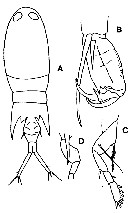 issued from : Y.S. Kang, S.-H. Huh & S.S. Lee in J. Ocanol. Soc. Korea, 1990, 25 (2). [Pl. 1, Figs.A-D]. Female (from S Korea): A, habitus (dorsal); B, A2; C, P4; D, genital segments (lateral). Nota: Cephalothorax 4-segmented. Lateral points of 3rd thoracic segment over half the length of the genital segment. Caudal rami as long as the urosome, and divergent.
|
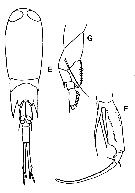 issued from : Y.S. Kang, S.-H. Huh & S.S. Lee in J. Ocanol. Soc. Korea, 1990, 25 (2). [Pl. 1, Figs.E-G]. Male: E, habitus (dorsal); B, A2; C, P4. Lateral points of 3dd thoracic segment over half the length of the genital segment. A2 with 1 long, sharp tooth at the inner distal edge of basipod 2. Caudal rami 12 times longer than wide and 4/5 the length of the urosome.
|
 issued from : T. Mori in The Pelagic copepoda from the neighbouring waters of Japan, 1937 (1964). [Pl. 72, Figs.13-15]. Female: 13, P4; 14, habitus (dorsal); 15, A2.
|
 issued from : T. Mori in The Pelagic copepoda from the neighbouring waters of Japan, 1937 (1964). [Pl. 72, Figs.9-12]. Male: 9, habitus (dorsal); 10, P4; 11, A2; 12, abdomen.
|
 [O & F] Female: Caudal rami approximately as long as the genital segment + anal segment. Male: Caudal rami approximately as long as the urosome. [B & H] Female: Caudal rami about as long as 2 preceding urosome somites combined. First endopodal segment of A2 with 2 pointed teeth on inner distal margin. Male: Caudal rami sometimes longer than in female. Anal somite more than twice as long as wide in dorsal view. [V & S] Female: Caudal rami equal or superior to the abdominal segments. (rapport ±19/20.5). Male: Caudal rami equal or superior to the abdominal segments. (rapport ± 15/18.5).
|
 Issued from : F. Vives & A.A. Shmeleva in Fauna Iberica, 2010, 33. [p.207, Fig.92]. After M. Dahl, 1912; Cervigon, 1964. Female: A, habitus (dorsal); B, A2; C, P4. Male: D, habitus (dorsal); E, A2.
| | | | | Ref. compl.: | | | Cleve, 1904 a (p.189); Pearson, 1906 (p.34); Carl, 1907 (p.18); Wilson, 1932 (p.42); Oliveira, 1945 (p.191); Wilson, 1950 (p.196); Yamazi, 1958 (p.155, Rem.); Deevey, 1960 (p.5, Table II, annual abundance) ; Fagetti, 1962 (p.54); Cervigon, 1962 (p.181, tables: abundance distribution); Ganapati Shanthakumari, 1962 (p.10, 16); Gaudy, 1963 (p.32, Rem.); Björnberg, 1963 (p.84, Rem.); De Decker, 1964 (p.15, 21, 30); De Decker & Mombeck, 1964 (p.12); Furuhashi, 1966 a (p.295, vertical distribution in Kuroshio region, Table 9, 10); Neto & Paiva, 1966 (p.32, Table III, annual cycle); Mazza, 1966 (p.74); Ehrhardt, 1967 (p.744, geographic distribution, Rem.); Séguin, 1968 (p.488); Delalo, 1968 (p.139); Lubny-Gertzyk, 1968 (p.276); Dowidar & El-Maghraby, 1970 (p.268); Deevey, 1971 (p.224); Binet & al., 1972 (p.73); Ibanez & Seguin, 1972 (p.81, annual cycle, multivarite analysis); Björnberg, 1973 (p.367, 385); Palet, 1975 (p.660); Boxshall, 1977 b (p.553); Deevey & Brooks, 1977 (p.156, tab.2, Station "S"); Dessier, 1979 (p.153, 202, 208); Herman & Mitchell, 1981 (p.739, Table 2, length-volume); Rudyakov, 1982 (p.208, Table 2); Vives, 1982 (p.296); Kovalev & Shmeleva, 1982 (p.86); Turner & Dagg, 1983 (p.16, 22); Guangshan & Honglin, 1984 (p.118, tab.); Bityukov & al., 1984 (tab.1); Sazhina, 1985 a (p.491, tab.3); Brinton & al., 1986 (p.228, Table 1); M. Lefèvre, 1986 (p.33); Renon, 1987 (tab.2); Diouf & Diallo, 1987 (p.260); Jimenez-Perez & Lara-Lara, 1988; Lozano Soldevilla & al., 1988 (p.61); Dessier, 1988 (tabl.1); Böttger-Schnack & al., 1989 (p.1089); Hernandez-Trujillo, 1989 a (tab.1); Cervantes-Duarte & Hernandez-Trujillo, 1989 (tab.3); Hirakawa & al., 1990 (tab.3); Othman & al., 1990 (p.561, 564, Table 1); Yoo, 1991 (tab.1); Dai & al., 1991 (tab.1); Hirakawa, 1991 (p.376: fig.2); Hernandez-Trujillo, 1991 (1993) (tab.I); Palomares Garcia & Vera, 1995 (tab.1); Webber & Roff, 1995 (tab.1); Shih & Young, 1995 (p.76); Böttger-Schnack, 1996 (p.1087); Webber & al., 1996 (tab.1); Kotani & al., 1996 (tab.2); Go & al., 1997 (tab.1); Suarez-Morales & Gasca, 1997 (p.1525); Park & Choi, 1997 (Appendix); Alvarez-Cadena & al., 1998 (t.1,2,3,4); Hopcroft & al., 1998 (tab.2); Hsieh & Chiu, 1998 (tab.2); Noda & al., 1998 (p.55, Table 3, occurrence); Suarez-Morales, 1998 (p.345, Table 1); Suarez-Morales & Gasca, 1998 a (p.112); Hernandez-Trujillo, 1999 (p.284, tab.1); Lavaniegos & Gonzalez-Navarro, 1999 (p.239, Appx.1); Neumann-Leitao & al., 1999 (p.153, tab.2); Dolganova & al., 1999 (p.13, tab.1); Lopes & al., 1999 (p.215, tab.1); Lapernat, 2000 (tabl. 3, 4); El-Sherif & Aboul Ezz, 2000 (p.61, Table 3: occurrence); Fernandez-Alamo & al., 2000 (p.1139, Appendix); Suarez-Morales & Gasca, 2000 (1247, tab.1); Suarez-Morales & al., 2000 (p.751, tab.1); Alvarez-Silva & Gomez-Aguirre, 2000 (p.163: tab.2); Lopez-Salgado & al., 2000 (tab.1); Lo & al., 2001 (1139, tab.I); Zerouali & Melhaoui, 2002 (p.91, Tableau I); Hernandez-Trujillo & Suarez-Morales, 2002 (p.748, tab.1); Hwang & al., 2003 (p.193, tab.2); Hsieh & al., 2004 (p.398, tab.1); Rezai & al., 2004 (p.490, tab.2); Chang & Fang, 2004 (p.456, tab.1); Daly Yahia & al., 2004 (p.366, fig.4, tab.1); Lan & al., 2004 (p.332, tab.1); Lo & al.*, 2004 (p.218, fig.6); Lo & al., 2004 (p.89, tab.1); Wang & Zuo, 2004 (p.1, Table 2, dominance, origin); Alvarez-Silva al., 2005 (p.39); Obuid Allah & al., 2005 (p.123, occurrence % vs metal contamination); Zenetos & al., 2005 (p.63, Rem.: p.82, casual occurrence); Zuo & al., 2006 (p.163: tab.1); Hwang & al., 2006 (p.943, tabl. I); Lopez-Ibarra & Palomares-Garcia, 2006 (p.63, Tabl. 1, seasonal abundance vs El-Niño); Rakhesh & al., 2006 (p.93, Table 2, spatial distribution); Sterza & Fernades, 2006 (p.95, Table 1, occurrence); Dias & Araujo, 2006 (p.84, Rem., chart); Lavaniegos & Jiménez-Pérez, 2006 (p.142, tab.2, Rem.); Khelifi-Touhami & al., 2007 (p.327, Table 1); Hwang & al., 2007 (p.25); Jitlang & al., 2008 (p.65, Table 1); Rakhesh & al., 2008 (p.154, Table 5; abundance vs stations); McKinnon & al., 2008 (p.843: Tab.I, p.848: Tab. IV); Neumann-Leitao & al., 2008 (p.799: Tab.II, fig.6); Morales-Ramirez & Suarez-Morales, 2008 (p.524); Fernandes, 2008 (p.465, Tabl.2); Ayon & al., 2008 (p.238, Table 4: Peruvian samples); Muelbert & al., 2008 (p.1662, Table 1); Gaard & al., 2008 (p.59, Table1, N Atlantic Mid-Ridge); Selifonova & al., 2008 (p.305, Tabl. 2); Tseng L.-C. & al., 2008 (p.153, Table 2, occurrence vs geographic distribution); Lan Y.-C. & al., 2008 (p.61, Table 1, % vs stations); Lopez Ibarra, 2008 (p.1, Table 1, fig.11); C.-Y. Lee & al., 2009 (p.151, Tab.2); Miyashita & al., 2009 (p.815, Tabl.II); Magalhaes & al., 2009 (p.187, Table 1, %); Drira & al., 2010 (p.145, Tanl.2); Williamson & McGowan, 2010 (p.273, Table 3, Pacific central gyres: N and S); Hernandez-Trujillo & al., 2010 (p.913, Table 2); Hidalgo & al., 2010 (p.2089, Table 2); Dias & al., 2010 (p.230, Table 1); Medellin-Mora & Navas S., 2010 (p.265, Tab. 2); Fazeli & al., 2010 (p.153, Table 1); W.-B. Chang & al., 2010 (p.735, Table 2, 3, abundance); Xu & Gao, 2011 (p.514, figs.3, 4, Table 2: optimal salinity); Guo & al., 2011 (p.567, table 2, indicator); Hsiao S.H. & al., 2011 (p.475, Appendix I); Hsiao & al., 2011 (p.317, Table 2, indicator of seasonal change); Kâ & Hwang, 2011 (p.155, Table 3: occurrence %); Tseng L.-C. & al., 2011 (p.47, Table 2, occurrences vs mesh sizes); Maiphae & Sa-ardrit, 2011 (p.641, Table 2, 3, Rem.); Selifonova, 2011 a (p.77, Table 1, alien species in Black Sea); Tutasi & al., 2011 (p.791, Table 2, abundance distribution vs La Niña event); Uysal & Shmeleva, 2012 (p.909, Table I); Lavaniegos & al., 2012 (p. 11, Table 1, seasonal abundance, Appendix); Tseng & al., 2012 (p.621, Table 3: abundance); Jang M.-C & al., 2012 (p.37, abundance and seasonal distribution); Miyashita & al., 2012 (p.1557, Table 2: occurrence); Almeida LR. & al., 2012 (p.13, Table 1, abundance); Rekik & al., 2012 (p.336, Table 1, abundabce); Gubanova & al., 2013 (in press, p.4, Table 2); Palomares-Garcia & al., 2013 (p.1009, Table I, abundance vs environmental factors); in CalCOFI regional list (MDO, Nov. 2013; M. Ohman, pers. comm.); Tachibana & al., 2013 (p.545, Table 1, seasonal change 2006-2008); Tseng & al., 2013 (p.507, seasonal abundance); Jagadeesan & al., 2013 (p.27, Table 3, seasonal abundance); Anjusha & al., 2013 (p.40, Table 3, abundance & feeding behavior); Mendoza Portillo, 2013 (p.42: Fig.10, biomass); Lidvanov & al., 2013 (p.290, Table 2, % composition); Hwang & al., 2014 (p.43, Appendix A: seasonal abundance); Bonecker & a., 2014 (p.445, Table II: frequency, horizontal & vertical distributions); Marquez-Rojas & al., 2014 (p.5, Rem., %); Zaafa & al., 2014 (p.67, Table I, occurrence); Dias & al., 2015 (p.483, Table 2, abundance, biomass, production); Rojas-Herrera & al., 2016 (p.40, Table 2: temporal abundance); Benedetti & al., 2016 (p.159, Table I, fig.1, functional characters); Ben Ltaief & al., 2017 (p.1, Table III, Summer relative abundance); Atique & al., 2017 (p.1, Table 1); Marques-Rojas & Zoppi de Roa, 2017 (p.495, Table 1); Dias & al., 2018 a (p.189, Rem.: p.196); Palomares-Garcia & al., 2018 (p.178, fig.3: relative frequency, Table 1); Acha & al., 2020 (p.1, Table 3: occurrence % vs ecoregions). | | | | NZ: | 20 + 2 douteuses | | |
|
Carte de distribution de Corycaeus (Corycaeus) speciosus par zones géographiques
|
| | | | | | | | | | | | | | |  issued from : H.B. Owre & M. Foyo in Fauna Caribaea, 1, Crustacea, 1: Copepoda. Copepods of the Florida Current. 1967. [p.121, Table 61]. issued from : H.B. Owre & M. Foyo in Fauna Caribaea, 1, Crustacea, 1: Copepoda. Copepods of the Florida Current. 1967. [p.121, Table 61].
Vertical distribution of Corycaeus (C.) speciosus at the ''40-Mile Station'' in the Florida Current ( E Miami: ± 25°35'N, 79°27'W; depth 738 m).
SL 53: 18 V 1958; SL 55: 21 VII 1958. A: during midday; B: during midnight. |
| | | | Loc: | | | Antarct. (in Wolfenden, 1911), South Africa (E & W), off N Tristan da Cunha, Angola, Baia Farta, off St. Helena Is. (S & N), Congo, off Trindade Is., off S Ascension Is., G. of Guinea, off Lagos, Abidjan, Casamance, off E St. Paul Is., Cape Verde Is., off NW Cape Verde Is., off Morocco-Mauritania, Canary Is., off S Azores, Argentina, Uruguay (continental shelf), Brazil (S, Paranagua Bay, Rio de Janeiro, Campos Basin, Vitoria Bay, off Vitoria-Cabo de Sao Tomé, off Macaé, Guarairas Lagoon, off Natal, Curuça estuary, Caeté Estuary), Barbada Is., Caribbean Sea, Jamaica, Bahia de Mochima & Cariaco Gulf (Venezuela), Caribbean Colombia, Cariaco Basin, Yucatan, G. of Mexico, Cuba, Florida, Chesapeake Bay, Sargasso Sea, off Bermuda (Station "S"), Delaware Bay (outside), New York, Long Island, off Woods Hole, off S Newfoundland,Valentia Island, Ireland, off W Tangier, Medit. (Alboran Sea, Gulf of Annaba, Castellon, G. of Lion, Marseille, Tyrrhenian Sea, Gulf of Taranto, NW Tunisia, Sfax, G. of Gabès, Lebanon Basin, W Egyptian coast, Alexandria, W Black Sea), ? Suez Canal, Sharm El-Sheikh, Safâga, Red Sea, Gulf of Oman, G. of Aden, Arabian Sea, Laccadive Is., Maldives Is., Port Natal, Madagascar, Rodrigues Is., Seychelles, Sri Lanka, Indian, India (G. of Mannar, Palk Bay, Saurashtra coast, Lawson's Bay, Kakinada Bay, Godavari region), Bay of Bengal, Nicobar Is., Christmas Is., Straits of Malacca, G. of Thailand, Indonesia-Malaysia, Ambon Bay, Philippines, Viet-Nam, China Seas (Yellow Sea, East China Sea, South China Sea, Xiamen Harbour), Taiwan Strait, Taiwan (E, S, SW, W, Kaohsiung Harbor, NW, N, NE, Mienhua Canyon), Okinawa, S Korea, Korea Strait, Japan Sea, Japan, Kuchinoerabu Is., Tanabe Bay, Tokyo Bay, Kuroshio zone, Bikini Is., Kamchatka, Bering Sea, Aleutian Is., Pacif. (W equatorial), Pacific (central gyres: N and S), Australia (Great Barrier, New Wales South, Shark Bay, North West Cape, G. of Carpentaria), New Caledonia, off New Zealand, Fidji Is., Moorea Is., Gilbert Is., off Hawaii, off Washington, California, W Baja California (Bahia Magdalena: very abundant), Gulf of California, Mazatlan Bay, Zihuatanejo Bay, La Paz, W Mexico, Acapulco Bay (rare), G. of Tehuantepec, W Costa Rica, Clipperton Is., Panama, Bahia Cupica §Colombia), off Galapagos, Ecuador, Peruvian shelf, Chile (N-S) | | | | N: | 284 | | | | Lg.: | | | (11) F: 1,98-1,75; (45) F: 2,15-1,85; M: 0,85-0,75; (46) F: 2,15-1,9; M: 1,85-1,8; (66) F: 2,05; 1,69; M: 1,62; (84) F: 1,85; M: 1,58; (104) F: 2,3; M: 1,9; (107) F: 1,97-1,86; M: 1,62-1,48; (109) F: 2,07-1,95; M: 1,77-1,6; (135) F: 2,55; (180) F: 2-2,14; M: 1,76-1,6; (237) F:2,5; M: 1,95; (531) F: 1,6; M: 0,8; (332) F: 1,96-1,64; M: 1,59-1,32; (333) F: 1,98-1,41; M: 1,88-1,8; (336) F: 2,29-1,9; M: 2-1,5; (618) F: 1,37; (651) F: 2,26-2,01; M: 1,88-1,64; (666) [Atlant.] F: 2,2-2; M: 1,78-1,75; [Indo-Pacif.] F: 1,96-1,78; M: 1,7-1,49; (667) F: 2,18-2; M: 1,9-1,63; (668) F: 2,1-2,03; M: 1,82; (785) F: 2,11; 2,05; M: 1,59-1,31; (786) F: 1,97-1,89; M: 1,72-1,66; 1,8-1,45; (788) F: 1,78-1,58; M: 1,48-1,26; (864) F: 1,42-1,8; (991) F: 1,9-2,18; M: 1,48-1,9; (1047) F: 1,8; {F: 1,37-2,55; M: 0,75-2,00} | | | | Rem.: | épi-mésopélagique, parfois bathypélagique.
Voir aussi les remarques en anglais | | | Dernière mise à jour : 28/10/2022 | |
|
|
 Toute utilisation de ce site pour une publication sera mentionnée avec la référence suivante : Toute utilisation de ce site pour une publication sera mentionnée avec la référence suivante :
Razouls C., Desreumaux N., Kouwenberg J. et de Bovée F., 2005-2025. - Biodiversité des Copépodes planctoniques marins (morphologie, répartition géographique et données biologiques). Sorbonne Université, CNRS. Disponible sur http://copepodes.obs-banyuls.fr [Accédé le 04 décembre 2025] © copyright 2005-2025 Sorbonne Université, CNRS
|
|
 |
 |
























